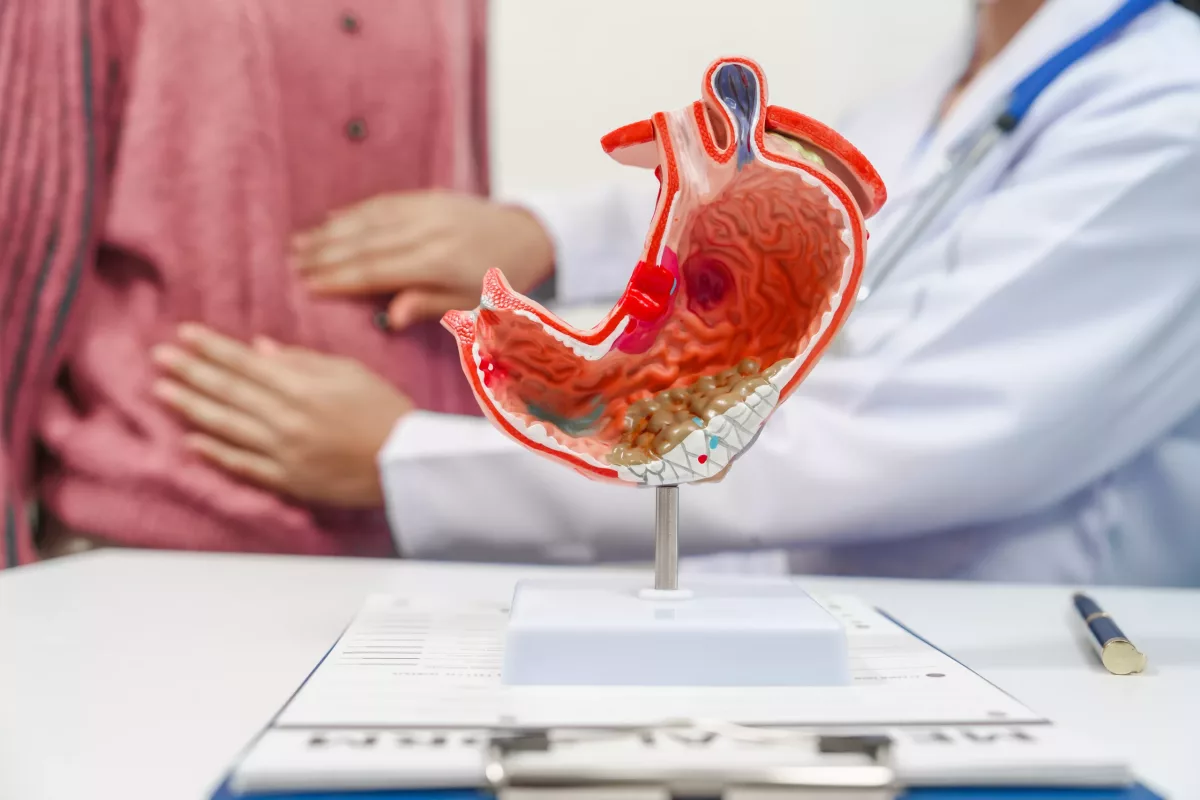A health condition in which the stomach lining begins to bleed and then causes stripes similar to those on a watermelon is called watermelon stomach or gastric antral vascular ectasia (GAVE). These stripes cannot be seen unless your doctor looks inside the stomach with an endoscope (a long and flexible tube with a camera on the end). The most common symptoms include anemia, bloody stools, and vomiting blood. Physicians usually recommend medicines or surgery to treat this condition.
This condition often occurs due to blood vessels that weaken and begin to bleed. It also allows the formation of vertical stripes inside the stomach.
Generally, this is a rare condition that is often caused by stomach ulcers or varices (enlarged blood vessels). While anyone may develop this condition, it is mostly diagnosed in people over 70 years old.
Symptoms
Check below some symptoms that are often experienced by people with watermelon stomach:
- Iron-deficiency anemia
- Nausea
- Vomiting blood
- Bloody stools
- Internal bleeding (also known as hemorrhage)
- Fatigue (extreme tiredness)
- Abdominal (belly) pain
Sometimes, people with this condition do not experience any symptoms. In such cases, it is quite difficult to diagnose it. If you notice any of the previous symptoms, immediately contact your healthcare professional.
What Causes Watermelon Stomach?
Experts do not fully understand why some older people develop this condition and others do not. However, they think that a combination of the following health problems could play a role. For example:
- Hypergastrinemia – This is a condition that causes the levels of Gastrin (an important hormone that helps with digestion) to increase significantly.
- Achlorhydria – It occurs when the stomach does not produce enough hydrochloric acid (a specific substance used to break down the food).
- Reduced levels of Pepsinogen – This is an important enzyme also used to digest food.
- Liver failure – This is a dangerous condition in which the liver no longer works. It may also cause enlarged blood vessels.
Risk Factors
While doctors cannot determine the exact cause of this condition, they have identified some factors that may increase your risk of developing a watermelon stomach. Check some examples below:
- Autoimmune diseases (such as systemic sclerosis)
- Atrophic gastritis
- Diabetes
- Heart disease
- Kidney failure
- Cirrhosis
- Metabolic syndrome
- Anemia (especially severe iron-deficiency anemia)
- Sex – Women are more likely to develop GAVE than men.
- Age – This condition is mostly diagnosed in older people.
How to Prevent Watermelon Stomach?
In general, there is no way to prevent this condition because healthcare providers do not know what causes it. However, you can talk with your physician about ways to reduce the risk of developing it. These may include lifestyle and dietary changes, treating existing chronic health conditions, smoking cessation, and others.
Diagnosis
Doctors usually perform a physical examination to check for irregularities linked to the disease and may ask some questions about your symptoms and medical history. If they suspect GAVE, you may be referred to a gastroenterologist. Sometimes, to confirm the condition and exclude others that cause similar symptoms, physicians may perform some tests. Check below some of them:
- Upper endoscopy – During this procedure, doctors will use an endoscope (a thin and flexible tube with a lighted camera on the end) to examine the inside of the stomach.
- Biopsy – This procedure involves the removal of a small sample of the affected tissue for testing under a microscope.
- Blood tests – These tests are often done to check for a low red blood cell count (anemia).
Treatment
Fortunately, there are multiple treatment options that help lessen the symptoms and improve your quality of life. However, people who have lost a lot of blood usually need emergency blood transfusions. Generally, treatment is prescribed differently for each person with a watermelon stomach because it depends on several factors. These include existing health problems, the severity of the condition, your age and preferences, and others. Check below some treatments usually recommended by doctors for people with GAVE:
Iron Supplements
These supplements are often recommended by doctors when the disease is found in its early stages. However, this treatment is not for everyone, and those who administer iron supplements still need a blood transfusion to reduce internal bleeding.
Medicines
Sometimes, physicians may recommend the following medications to reduce bleeding. However, it is not recommended to use them for long periods. For example:
- Corticosteroids (this group of medicines is usually recommended to reduce inflammation)
- Octreotide
- Hormonal therapy
Endoscopic Treatment Options
This treatment is one of the most common treatments used to treat a watermelon stomach. The following procedures help destroy affected blood vessels and stop bleeding. For example:
- Argon plasma coagulation (APC) – This is the most common type of endoscopic surgery used to treat this disease. It uses a gas (argon) to burn (cauterize) and seal affected blood vessels.
- Endoscopic band ligation (EBL) – This is a specific treatment that involves a band that is placed around each damaged blood vessel to close it. In some cases, physicians may perform both APC and EBL at the same time.
- Radiofrequency ablation (RFA) – Doctors recommend this treatment, which uses radio waves to destroy damaged or ruptured blood vessels.
- Cryotherapy – This treatment uses nitrous oxide to freeze affected blood vessels and stop hemorrhage.
Previous treatments are usually performed several times to notice improvements. For more details, discuss it with your physician.
Blood Transfusions
This treatment is used to help people who have severe bleeding. Usually, they need multiple blood transfusions. However, supplements, medicines, and endoscopic surgery help reduce the need for this treatment over time. People need blood transfusions until doctors reduce internal bleeding.
Surgery
This treatment is often recommended by physicians when previous treatment options do not work. They often perform a partial gastrectomy that involves the removal of the damaged part of your stomach. When you choose this treatment, blood transfusions are no longer needed.
If APC (a less invasive procedure) does not help, gastrectomy is the only way to cure watermelon stomach.
Frequently Asked Questions
What is the cause of a watermelon stomach?
While experts do not fully understand why GAVE happens, they think a combination of the following health problems could play a role. For example, hypergastrinemia, liver disease (such as cirrhosis or liver failure), blood vessel disease, and others.
Are there foods to avoid with a watermelon stomach?
The treatment for this condition involves dietary changes along with medicines, supplements, and other procedures. Thus, you should avoid the following products as they can worsen the symptoms. For example:
- Caffeine
- Illegal drugs
- Alcohol
- Acidic or spicy foods (these include tomatoes, citrus fruits, vinegar, chili peppers, and others)
- Fatty foods (such as butter, whole milk, and others)
- Dairy products
- Some fruits and vegetables (such as onions, garlic, and mushrooms)
For more details, discuss it with your doctor.
What is the best treatment for watermelon stomach?
Usually, people notice improvements after endoscopic laser surgery or argon plasma coagulation. Ask your doctor if you have additional questions.




